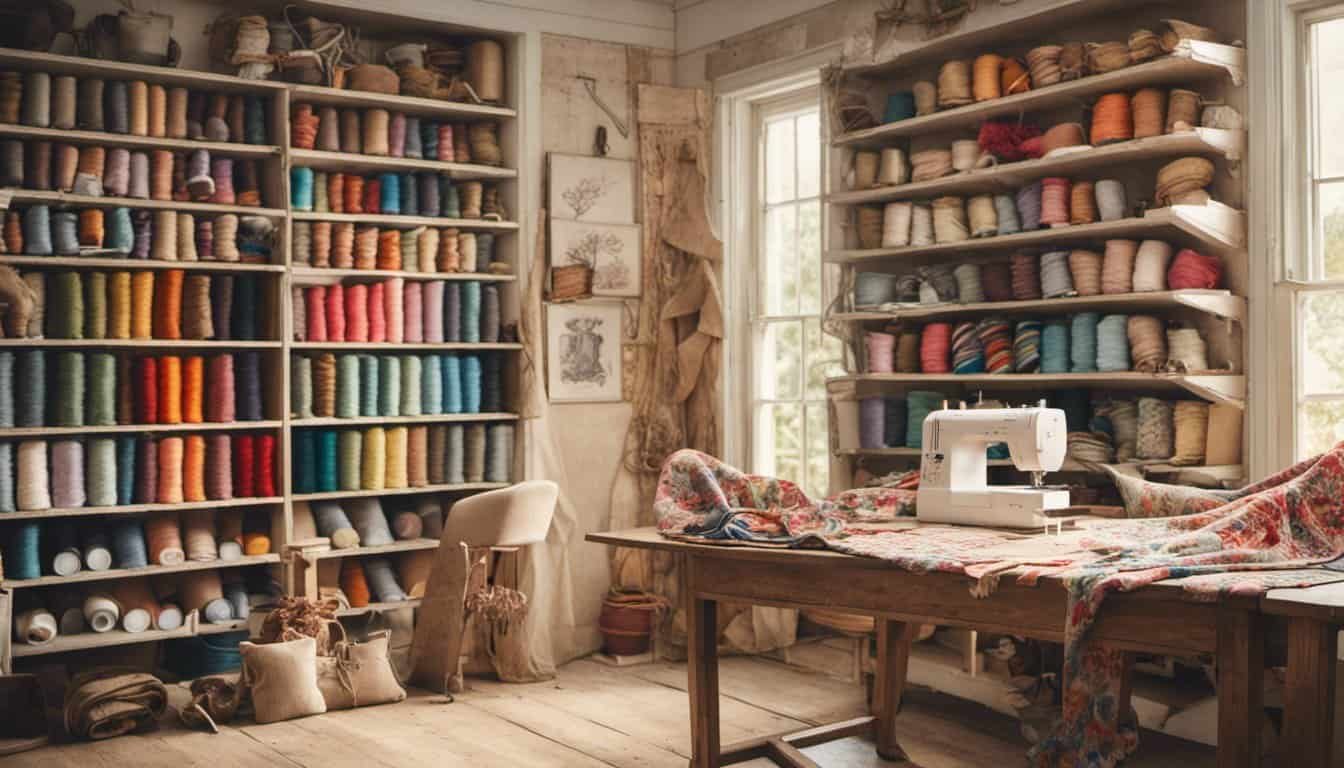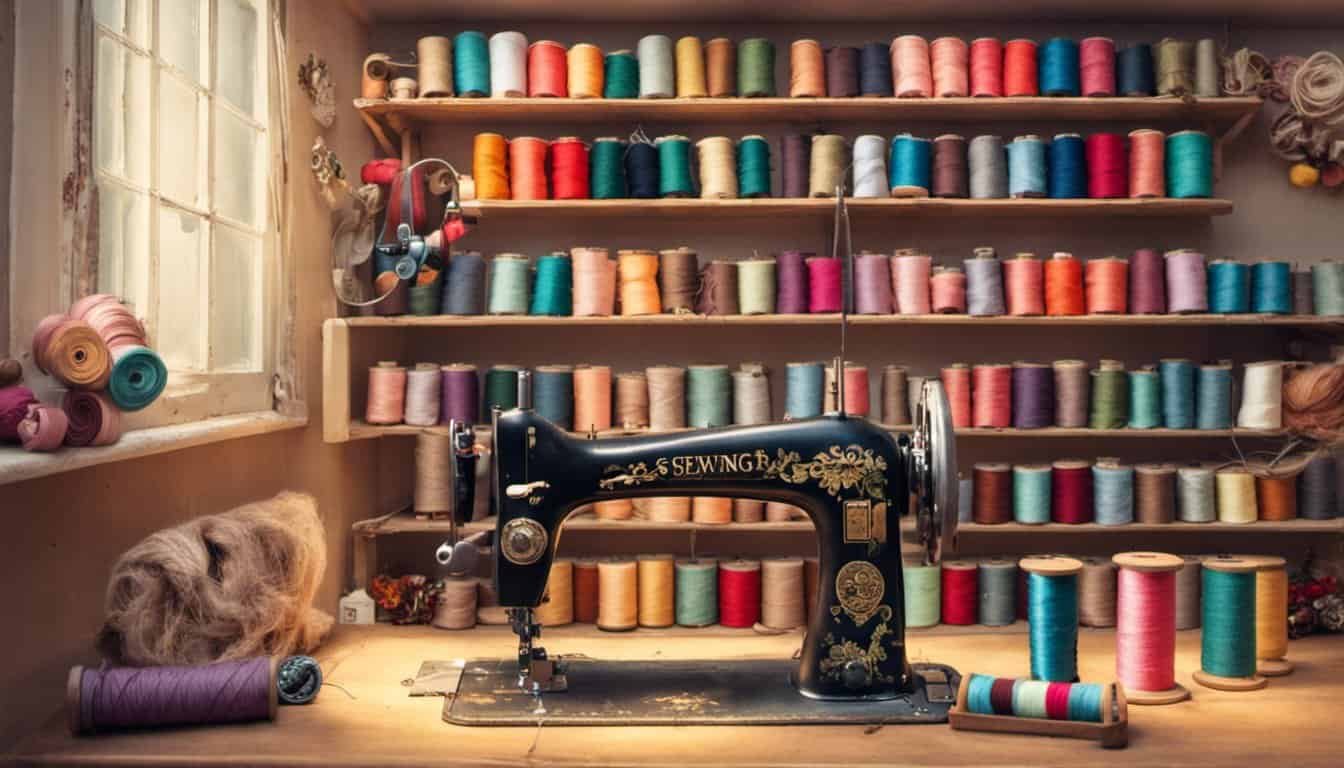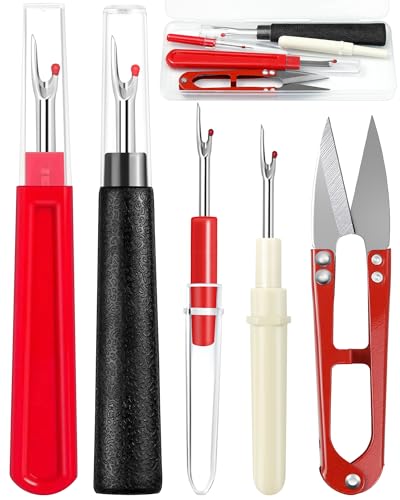When I first started sewing, getting a straight stitch felt like an uphill battle. But once you get the hang of it, it’s a fundamental skill that makes all your projects look professional. Sewing straight lines is more than just about threading your machine correctly; it’s about understanding the rhythm and ensuring consistency with every pass.
Understanding Your Sewing Machine
Familiarizing myself with my sewing machine is crucial for sewing straight stitches effectively. Here are the key components that play a role:
- Presser Foot
The presser foot holds the fabric in place; adjusting its pressure ensures smooth fabric movement.
- Feed Dogs
Feed dogs guide the fabric; cleaning them regularly prevents skipped stitches.
- Needle
Choosing the right needle type and size affects stitch quality; a bent needle can disrupt stitching.
- Thread Tension Dial
Proper tension settings create balanced stitches; incorrect tension can cause puckering or loose stitches.
- Bobbin Case
The bobbin case controls the lower thread; ensuring it’s correctly inserted avoids thread jams.
- Stitch Selector
Selecting the straight stitch mode ensures consistent stitch patterns; double-checking settings prevents accidental stitch types.
- Thread Guides
Proper threading through all guides maintains thread flow; skipping guides can lead to tangled threads.
Understanding these components enhances my ability to troubleshoot and maintain my machine, ensuring straight stitches every time.
Setting Up for a Straight Stitch
Getting your machine ready is crucial for perfect straight stitches. Here’s how I ensure everything is set correctly.
Choosing the Right Thread and Needle
Selecting the appropriate thread and needle enhances stitch quality. I use polyester thread for general sewing because it’s strong and versatile. For delicate fabrics, cotton thread works best. The needle type matters too. A universal needle fits most fabrics, while a sharp needle is ideal for woven materials. Always match the needle size to your fabric weight:
- Light fabrics (e.g., chiffon, silk): Size 60/8 or 70/10
- Medium fabrics (e.g., cotton, linen): Size 80/12
- Heavy fabrics (e.g., denim, canvas): Size 90/14 or higher
Adjusting the Stitch Length and Tension
Proper stitch length and tension ensure even, straight stitches. I typically set the stitch length to 2.5 mm for a balanced stitch. Adjusting tension involves turning the tension dial:
- Too tight: Fabric puckers
- Too loose: Stitches appear slanted
Here’s a quick reference table for adjustments:

| Issue | Adjustment |
|---|---|
| Puckering fabric | Decrease upper tension |
| Slanted stitches | Increase upper tension |
| Loose stitches | Tighten upper tension |
| Thread bunching | Lower upper tension |
I always test settings on a scrap piece to find the optimal balance before sewing your project.
Step-by-Step Guide to Sewing a Straight Stitch
- Prepare Your Sewing Machine
Ensure the machine is plugged in and turned off before setting it up. Lower the presser foot to release fabric tension. Remove any leftover threads from previous projects to prevent jams.
- Thread the Machine Correctly
Begin by placing the spool of polyester thread on the spool pin. Follow the threading path diagram specific to your machine model. Guide the thread through the tension discs and the take-up lever, then through the needle from front to back.
- Insert the Bobbin
Open the bobbin case and insert the wound bobbin clockwise. Pull the bobbin thread through the slot and under the tension spring. Ensure the bobbin spins freely without resistance.
- Select Stitch Settings
Turn the stitch selector to the straight stitch option. Adjust the stitch length to 2.5 mm for standard sewing. Set the thread tension dial to medium (usually around 4) to maintain balanced stitches.
- Prepare Your Fabric
« Unlock the Secret: How to Sew a Scalloped Hem with a Machine Like a Pro
Master How to Sew a Rolled Hem with a Sewing Machine in Just 5 Simple Steps »
Place the fabric under the presser foot, aligning the edge with the guide marks. Lower the presser foot to hold the fabric in place. Ensure the fabric is smooth and free of wrinkles for even stitching.
- Start Sewing
Hold the thread tails gently and press the foot pedal to begin. Guide the fabric steadily without pulling or pushing. Maintain a consistent speed to ensure straight, uniform stitches.
- Finish the Stitch
Once you reach the end of the seam, lift the presser foot and turn the handwheel to raise the needle. Pull the fabric gently to remove it from the machine. Trim any excess threads close to the seam.
- Test Your Stitches
Sew a few stitches on a scrap piece of fabric to verify settings. Check for straightness and uniformity. Adjust stitch length or tension if necessary before starting your main project.
| Step | Action |
|---|---|
| 1. Prepare Machine | Plug in, lower presser foot, clear threads |
| 2. Thread Correctly | Follow threading path, guide through needle |
| 3. Insert Bobbin | Place clockwise, pull thread through slot |
| 4. Select Settings | Choose straight stitch, set length & tension |
| 5. Prepare Fabric | Align with guides, smooth fabric |
| 6. Start Sewing | Press pedal, guide fabric steadily |
| 7. Finish Stitch | Lift foot, pull fabric, trim threads |
| 8. Test Stitches | Sew on scrap, adjust settings if needed |
Troubleshooting Common Issues
When sewing straight stitches, several issues might arise that can affect your project’s quality. Addressing these promptly ensures smooth progress and professional results.

Uneven Stitch Lengths
Uneven stitches disrupt the straightness of your seam. To fix this:
- Adjust Stitch Length: Ensure the stitch length is consistent. Short stitches (2.5mm) suit lightweight fabrics, while longer stitches (3.0mm) work for heavier materials.
- Check Thread Tension: Uneven tension can cause inconsistent stitch lengths. Refer to your machine’s manual to balance upper and bobbin tensions.
- Inspect the Needle: A bent or dull needle may skip stitches. Replace the needle regularly to maintain performance.
Thread Bunching or Looping
Bunched or looped threads compromise stitch clarity. Resolve this by:
- Re-threading the Machine: Incorrect threading can cause tension issues. Follow the threading path precisely as per your machine’s guidelines.
- Winding the Bobbin Properly: Ensure the bobbin is wound evenly and seated correctly. An improperly wound bobbin can disrupt thread flow.
- Using Quality Thread: Low-quality thread may fray or break easily. Opt for polyester or cotton threads suited to your fabric type.
Fabric Not Feeding Correctly
Improper fabric feeding leads to crooked seams. Improve feeding by:
- Raising the Presser Foot: A higher presser foot pressure enhances fabric grip, preventing slipping. Adjust using your machine’s presser foot pressure dial.
- Cleaning the Feed Dogs: Accumulated lint can hinder feed dogs. Regularly clean them with a small brush to ensure smooth fabric movement.
- Selecting Appropriate Feed Dogs: Some machines offer adjustable feed dogs. Choose the setting that matches your fabric thickness for optimal feeding.
Skipped Stitches
Skipped stitches disrupt the continuity of your seam. Prevent this by:
- Replacing the Needle: A dull or incorrect needle size causes skipped stitches. Select the right needle type and size for your fabric.
- Securing Thread Ends: Loose thread ends can create tension issues. Tie a knot at the beginning and end of your seam to stabilize the thread.
- Balancing Machine Tension: Uneven upper and bobbin tension can lead to skipped stitches. Adjust tension settings until stitches form evenly.
Stitch Not Straight
A curved or zigzag stitch affects the seam’s straightness. Correct this by:

- Aligning the Machine: Ensure your machine is on a stable, flat surface. Misalignment can cause the fabric to shift during sewing.
- Using Straight Stitch Settings: Verify that your machine is set to a straight stitch, not a zigzag or decorative stitch. Consult your machine’s stitch selector.
- Maintaining Consistent Pace: Sewing too quickly can lead to uneven stitches. Maintain a steady speed for uniform stitch formation.
Common Issues and Solutions
| Issue | Possible Cause | Solution |
|---|---|---|
| Uneven Stitch Lengths | Incorrect stitch length | Adjust stitch length settings |
| Imbalanced thread tension | Balance upper and bobbin tensions | |
| Thread Bunching | Improper threading | Re-thread the machine correctly |
| Poor bobbin winding | Rewind and reinstall the bobbin | |
| Fabric Feeding Problems | Low presser foot pressure | Raise presser foot pressure |
| Dirty feed dogs | Clean feed dogs regularly | |
| Skipped Stitches | Dull or incorrect needle | Replace with appropriate needle |
| Uneven thread tension | Adjust tension settings | |
| Stitch Not Straight | Machine misalignment | Ensure the machine is on a stable, flat surface |
| Incorrect stitch type | Select the straight stitch setting |
By systematically addressing these common issues, you can maintain straight stitching quality and enhance your sewing projects’ overall appearance.
Tips for Perfecting Your Straight Stitch
Achieving flawless straight stitches takes practice and attention to detail. Here are some essential tips to help you perfect your straight stitching:
Maintain Machine Cleanliness
Keep your sewing machine clean to ensure smooth operation. Regularly remove lint and dust from the bobbin area, feed dogs, and needle plate using a small brush. A clean machine prevents thread tangles and maintains stitch quality.
Use Quality Thread
Choose high-quality polyester or cotton thread suitable for your fabric. Superior thread reduces the chance of breakage and ensures even stitches. Always spool the thread correctly to facilitate smooth feeding through the machine.
Select the Right Needle
Match the needle type and size to your fabric. Use a fine needle (size 9/90) for lightweight fabrics and a stronger needle (size 14/90) for heavier materials. A suitable needle prevents skipped stitches and fabric damage.

Adjust Stitch Length
Set your stitch length between 2.5 and 3.0 for most projects. Shorter stitches can create bulk on thin fabrics, while longer stitches might not hold thick fabrics securely. Test stitch length on a scrap piece to find the best setting for your fabric.
Control Sewing Speed
Sew at a steady, moderate pace. Moving too fast can cause uneven stitches, while sewing too slowly may lead to skipped stitches. Consistent speed helps maintain uniform stitch quality.
Use Proper Fabric Handling
Guide the fabric gently without pulling or stretching. Let the feed dogs move the fabric at their own pace. For slippery fabrics, use a stabilizer or switch to a presser foot designed for such materials to keep the fabric in place.
Regularly Check Tension Settings
Balanced thread tension ensures even stitches. If the upper thread is too tight, it may cause puckering; if too loose, stitches can appear shaky. Adjust the tension dial as needed and test on scrap fabric to achieve balanced stitches.
Practice Consistently
Regular practice builds muscle memory and improves stitch consistency. Start with simple seams and gradually tackle more complex projects. Consistent practice enhances your ability to maintain straight lines effortlessly.

Use Guides and Markings
Employ sewing guides like ruler guides or stitching templates to maintain straight lines. Mark your fabric with tailor’s chalk to follow precise lines, ensuring accuracy throughout your project.
Inspect and Maintain Your Machine
Keep your sewing machine in optimal condition by performing regular maintenance. Change the needle after every project or after 8 hours of use, and oil the machine according to the manufacturer’s instructions. A well-maintained machine operates smoothly, producing high-quality straight stitches.
Implementing these tips will help you achieve perfect straight stitches, enhancing the professionalism and appearance of your sewing projects.
Conclusion
Mastering straight stitching opened up a whole new world of possibilities for my sewing projects. It’s amazing how a simple, consistent line can elevate the look and feel of any garment or craft. With the right setup and a bit of practice, I found that sewing straight stitches became second nature. The challenges along the way only made the successes sweeter and my confidence stronger. Now, I can tackle more complex patterns and designs knowing that my foundation is solid. Sewing truly is a journey and every straight stitch is a step forward. I’m excited to continue exploring and improving my skills, creating pieces that I’m proud to wear and share.


















